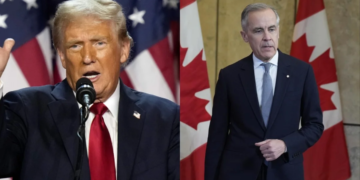On April 2, 2025, President Donald Trump announced a comprehensive tariff strategy, introducing a baseline 10% tariff on all imported goods into the United States, with additional “reciprocal” tariffs targeting specific countries. This policy aims to address perceived trade imbalances and protect American industries with new tariff rates.
Detailed Tariff Rates by Country
The following table outlines the newly imposed tariff rates for selected countries:
| Country | Tariff Rate |
|---|---|
| China | 34% |
| European Union | 20% |
| Japan | 24% |
| South Korea | 25% |
| Switzerland | 31% |
| United Kingdom | 10% |
| Taiwan | 32% |
| Malaysia | 24% |
| India | 26% |
| Brazil | 10% |
| Indonesia | 32% |
| Vietnam | 46% |
| Singapore | 10% |
| Ukraine | 10% |
| Venezuela | 15% |
These tariffs are set to take effect on April 6, 2025, for the baseline rate, with the additional country-specific tariffs commencing on April 9, 2025.
Rationale Behind the Tariffs

President Donald Trump initiated a series of trade tariffs on April 2 2025 to create changes in American foreign trade relations. The economic initiative named “Declaration of Economic Independence” received its name from President Trump who wanted to protect America’s industries from unfair trade practices. The president explained how these tariffs seek to end historical trade imbalance issues by protecting the U.S. economy from foreign nation exploitation methods. The government envisions that its tariff strategy will motivate industrial operations to move into U.S. territory where jobs and economic expansion will result.
Economic Implications
Multiple experts from the economic field warn these trade barriers could drive up product prices and intensify inflation within the economic system. The automotive market stands to receive a major economic impact thanks to the 25% import taxes on automobile imports and parts. Rising vehicle prices combined with supply chain disruptions may occur because of these measures. The charges imposed by these tariffs are predicted to boost prices of new vehicles by anywhere from $4,000 to $15,000 based on automotive assessment. Consumer reaction to higher prices will include delayed buying habits and migration toward the used car market to the detriment of prices in both markets.
These trade restrictions will likely generate economic consequences throughout the entire national economy. Higher import prices would lower purchasing power for consumers thereby decreasing market demand for multiple products and services. The economic growth rate may decrease because of these price increases and multiple industries that depend on imported materials may experience job diminishment. Companies with international supply chains must handle rising production expenses through either elevated consumer prices or smaller business profits.
New Tariff Rates: International Reactions
This news has generated different reactions from United States trading partners. China together with Japan and South Korea plan to unite their responses against U.S. trade restrictions which may result in retaliation measures. The Chinese state media disclosed that the three countries established an agreement to unite against the trade policy hurdles pursuant to the U.S. policies. Japanese and South Korean officials have given different indications about how extensively they are coordinating their responses. A South Korean trade ministry spokesperson told the press that a mutual response seemed overstated but Japanese government representatives denied any talks on joint measures.
Member nations of the European Union together with other affected countries analyze their strategic options regarding potential appropriate action. The current situation presents risks of worldwide trade conflicts. Foreign governments are considering economic protection through trade retaliations and additional restrictions. When countries resort to protectionist measures this will harm all parties while simultaneously destabilizing economic stability and international trade until trade barriers escalate.
Impact on the Automotive Industry
The automotive industry faces substantial market changes because of recently implemented tariffs. Ford and General Motors have noticed a significant growth in their vehicle sales before tariff enactment leading customers to purchase before pricing became higher. GM achieved a sales growth of 17% during the first quarter as Ford delivered 19% retail sales growth in March that extended to a 5% quarterly increase alongside an impressive 94% upswing in its EV sales. Ford saw its total sales decrease by 1% despite its yearly decline which came from the discontinuation of two models. Both automotive companies face major profit challenges because of the newly imposed Wednesday tariffs which target their Mexican-based U.S. market vehicle production.
Suppliers are also bracing for the impact. Magna, one of the world’s largest auto suppliers, is navigating significant industry challenges, including the new tariffs. The company has responded by adapting its operations to maintain production flexibility. However, smaller suppliers may face increased costs and decreased revenues, threatening their business viability.
Consumer Behavior and Market Dynamics
In anticipation of rising prices, consumers have been flocking to dealerships to purchase vehicles before the tariffs take effect. Car experts warn consumers to act swiftly but conscientiously, advising thorough research, price comparisons, and vehicle inspections to avoid costly mistakes or poor deals. The tariff will not apply to existing dealership inventory, making pre-tariff vehicles highly sought after. Automakers like Mazda, Volvo, and Volkswagen, which import a majority of their vehicles, are expected to be hit hardest. With nearly half of U.S. vehicle sales being imports, economists predict a rise in used car demand as new models become less affordable. Experts caution against rushed purchases and encourage consumers to read financing details closely and avoid unnecessary add-ons.















Discussion about this post